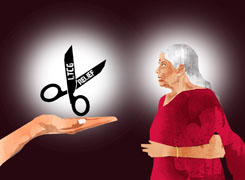Worried About My Future? 35 Year Old With Family Seeks Financial Security Advice
Ramalingam Kalirajan |10924 Answers |Ask -Follow
Mutual Funds, Financial Planning Expert - Answered on Feb 04, 2025
He has an MBA in finance from the University of Madras and is a certified financial planner.
He is the director and chief financial planner at Holistic Investment, a Chennai-based firm that offers financial planning and wealth management advice.... more

Hi Sir.. i came across this website and found many peoples' financial security questions were clarified with good advice. I'm now 35. Working in abroad. Right now my salary is good and can save, but can't say for the future, since there are decisions by the countries to give job preference to the citizens rather than expats. So just I want to start something save for future I haven't started investing in Stocks / Mutual Funds. Just planning to invest soon. Just a beginer in these areas. Apart from that I have own home, wife home, some land properties altogether adds to 2 to 3 Cr. But these are properties not planned for selling as these will have carry on to next generation. Please advice me for my future financial security for myself and wife, 2 Sons and If I plan for another kid. My Goals as below. I have a salary of 2.5L+ INR per month. I not planned for early retirement. Will just work based on my health conditions (right now ok). So i have to plan for 1. Son 1 (Age: 3) - Education & Marriage 2. Son 2 (Age: 6m)- Education & Marriage 3, 3rd kid if in case.... 4. Also If I want to buy a property (say 5 years once), how can I save or invest money. 5. Then a decent income of 75000 to 100000 per month in future once I started investing from now onwards. 6. Emergency funds. 7. Soon to buy a car (mostly 2nd hand) 1. I don't have any loans. 2. I don't have health insurance for myself or my family 3. I have started invested in HDFC Sanchay PLus 4. My expenses in India is around 15000 to 20000 per month 5. My abroad expenses around 40000 per month
1. Emergency Fund
Keep at least 6 to 12 months of expenses in a separate account.
Since your monthly expenses (India + abroad) are around Rs 60,000, maintain Rs 5-7 lakhs in a liquid fund or fixed deposit.
This will protect you from unexpected job loss or medical emergencies.
2. Health Insurance
Since you and your family don’t have health insurance, getting coverage is important.
Opt for a Rs 10-20 lakh family floater health insurance plan.
Choose a separate policy for your parents if they are dependent on you.
A good insurance policy will reduce the risk of medical expenses affecting your savings.
3. Investments for Children’s Education & Marriage
For Son 1 (Age: 3) & Son 2 (Age: 6 months)
Higher education costs in India and abroad are rising.
You need at least Rs 50-80 lakhs per child for higher education after 15 years.
Marriage expenses may require Rs 20-30 lakhs per child after 25 years.
Investment Plan:
Invest Rs 25,000 per month in a mix of equity mutual funds.
Split between large-cap, mid-cap, and flexi-cap funds.
Increase investment by 10% every year to match inflation.
Invest in regular mutual funds through a Certified Financial Planner (CFP) for expert guidance.
4. Future Property Purchase (Every 5 Years)
Buying a property every 5 years requires structured saving.
You should accumulate at least Rs 50-80 lakhs in 5 years for the next property.
Investment Plan:
Set aside Rs 40,000 per month in a combination of debt and equity funds.
For short-term (5 years), invest 60% in debt funds and 40% in equity funds.
This ensures capital safety while still getting growth.
5. Building Future Passive Income (Rs 75,000 to Rs 1 Lakh per Month)
To generate Rs 1 lakh per month, you need a corpus of Rs 2-3 crore.
Since you are just starting, a mix of growth and income-based investments is necessary.
Investment Plan:
Allocate Rs 50,000 per month to mutual funds with dividend options.
Invest in a mix of high-quality debt and equity funds for steady returns.
Increase investment as your salary grows.
6. Retirement Planning
You haven’t planned for early retirement, but financial freedom is important.
You need Rs 5-7 crore to retire comfortably by 55-60 years.
Investment Plan:
Invest Rs 50,000 per month in equity mutual funds.
Increase SIP amount as your income increases.
Later, shift investments to safer options like senior citizen schemes and annuities for retirement income.
7. Buying a Car (2nd Hand Car Soon)
If planning to buy in the next 6-12 months, keep the amount in a fixed deposit or liquid fund.
For a Rs 10 lakh car, set aside Rs 1 lakh per month for the next 10 months.
Avoid car loans since you have good savings potential.
8. Life Insurance Protection
If you don’t have term insurance, buy a Rs 2-3 crore term plan immediately.
This ensures your family is financially protected.
9. Investment Strategy for Beginners
Since you are new to stocks and mutual funds, start SIP investments in regular mutual funds.
Avoid index funds and direct plans, as actively managed funds provide better risk-adjusted returns.
Work with a Certified Financial Planner (CFP) to select the best funds.
10. Reviewing & Monitoring Investments
Review investments every 6 months with a Certified Financial Planner.
Rebalance asset allocation based on market conditions.
Increase SIP amounts as income grows.
Final Insights
Your current financial position is strong, and you have the potential to create long-term wealth.
A structured investment plan in mutual funds will secure your family’s future.
Protect your family with health and life insurance immediately.
Set clear financial goals and invest consistently.
Avoid unnecessary loans and focus on building assets.
Work with a Certified Financial Planner for better financial security.
Best Regards,
K. Ramalingam, MBA, CFP,
Chief Financial Planner,
www.holisticinvestment.in
https://www.youtube.com/@HolisticInvestment
You may like to see similar questions and answers below
Ramalingam Kalirajan |10924 Answers |Ask -Follow
Mutual Funds, Financial Planning Expert - Answered on Aug 20, 2024
Ramalingam Kalirajan |10924 Answers |Ask -Follow
Mutual Funds, Financial Planning Expert - Answered on Feb 10, 2025
Ramalingam Kalirajan |10924 Answers |Ask -Follow
Mutual Funds, Financial Planning Expert - Answered on Jun 02, 2025
Ramalingam Kalirajan |10924 Answers |Ask -Follow
Mutual Funds, Financial Planning Expert - Answered on Jul 07, 2025
Dr Dipankar Dutta |1842 Answers |Ask -Follow
Tech Careers and Skill Development Expert - Answered on Dec 23, 2025
Mayank Chandel |2580 Answers |Ask -Follow
IIT-JEE, NEET-UG, SAT, CLAT, CA, CS Exam Expert - Answered on Dec 23, 2025
Mayank Chandel |2580 Answers |Ask -Follow
IIT-JEE, NEET-UG, SAT, CLAT, CA, CS Exam Expert - Answered on Dec 23, 2025
Mayank Chandel |2580 Answers |Ask -Follow
IIT-JEE, NEET-UG, SAT, CLAT, CA, CS Exam Expert - Answered on Dec 23, 2025
Mayank Chandel |2580 Answers |Ask -Follow
IIT-JEE, NEET-UG, SAT, CLAT, CA, CS Exam Expert - Answered on Dec 23, 2025
Radheshyam Zanwar |6755 Answers |Ask -Follow
MHT-CET, IIT-JEE, NEET-UG Expert - Answered on Dec 23, 2025
Radheshyam Zanwar |6755 Answers |Ask -Follow
MHT-CET, IIT-JEE, NEET-UG Expert - Answered on Dec 23, 2025
Purshotam Lal |70 Answers |Ask -Follow
Financial Planner, MF and Insurance Expert - Answered on Dec 23, 2025
Purshotam Lal |70 Answers |Ask -Follow
Financial Planner, MF and Insurance Expert - Answered on Dec 23, 2025
Samraat Jadhav |2522 Answers |Ask -Follow
Stock Market Expert - Answered on Dec 23, 2025

























